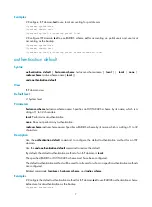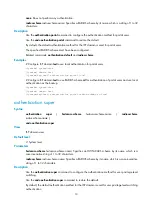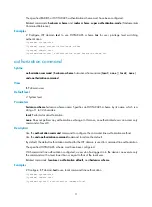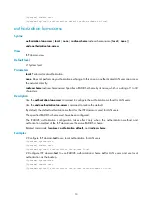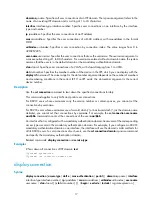
6
Description
Use the
accounting
optional
command to enable the accounting optional feature.
Use the
undo
accounting optional
command to disable the feature.
By default, the feature is disabled.
After you configure the
accounting optional
command for a domain, a user that will be disconnected
otherwise can continue to use the network resources when no accounting server is available or the
communication with the current accounting server fails. However, the device will not send real-time
accounting updates for the user anymore. The accounting optional feature applies to scenarios where
accounting is not important.
NOTE:
After you configure the
accounting optional
command, the setting by the
access-limit
command in local
user view is not effective.
Examples
# Enable the accounting optional feature for users in domain
test
.
<Sysname> system-view
[Sysname] domain test
[Sysname-isp-test] accounting optional
accounting portal
Syntax
accounting portal
{
local
|
none
|
radius-scheme
radius-scheme-name
[
local
] }
undo accounting portal
View
ISP domain view
Default level
2: System level
Parameters
local
: Performs local accounting.
none
: Does not perform any accounting.
radius-scheme
radius-scheme-name
: Specifies a RADIUS scheme by its name, which is a string of 1 to 32
characters.
Description
Use the
accounting portal
command to configure the accounting method for portal users.
Use the
undo accounting portal
command to restore the default.
By default, the default accounting method for the ISP domain is used for portal users.
The specified RADIUS scheme must have been configured.
Related commands:
local-user
,
accounting default
, and
radius scheme
.
















